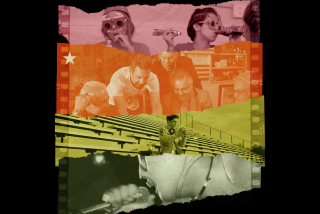Don’t call it Latino indie, but Helado Negro’s music is part of a rising form
- Share via
A diaspora can spread across borders or inside a single body. Roberto Lange, who plays at REDCAT as Helado Negro on Thursday, is a one-man band and self-contained diaspora. Growing up in South Florida as the child of Ecuadorean immigrants during the ‘80s, Lange started at the crossroads of more or less everything, all at once.
“My dad loved playing Julio Jaramillo, this sappy Ecuadorean crooner. My mom loved playing Sam Cooke records and dance music like Willie Colón. I would listen to my brother’s Boogie Down Production tapes,” Lange says. “My cousin hipped me to rave music, and jungle like Shy FX. In high school I loved weirdo stuff like Atari Teenage Riot, Autechre and anything on Warp, but I also listened to Jay Z and Biggie. When I was at the Savannah College of Art, records on Thrill Jockey and Drag City were a big influence. The world they were associated with suggested an ideal feeling of everything coming together with no borders. I associated myself with people trying to do their own thing, anyone who was alienated and felt the need to make their own community.”
SIGN UP for the free Essential Arts & Culture newsletter >>
Known as Helado Negro, Lange is part of an emergent movement based on fast but acute connections, musical and cultural communities using the Internet to make a hash of stereotypes and create affinity groups before gatekeepers see the gates. No genre names have taken root yet, and probably nobody in this cohort will like whatever the word ends up being. The links, though, are real and developing, between Lange and artists like Xenia Rubinos in New York and Algodón Egipcio in Mexico.
In 2011, I received Lange’s third full-length album, “Canta Lechuza,” in the mail. At first, the textures and Spanish lyrics brought to mind Cafe Tacuba, the experimental rock band from Mexico. After three songs, I had forgotten about reference points outside Lange’s work. There is a light, pliable feel to his music. No matter how fractured his sounds, Lange remains a crooner, unafraid to soothe, even when backed by tumbleweeds of static. Very few Helado Negro songs kick in, explode, or charge forward, choosing instead to remain rootless in a placid and stubborn way.

Lange drifted into music after graduating from the Savannah College of Art and Design in 2003 with a bachelor’s in computer art design and a minor in sound. At first interested in creating sound-based art installations, Lange worked with computers, keyboards, samples of records and his own warm tenor. He moved to Brooklyn in 2006 and soon started releasing music as Helado Negro, singing in both English and Spanish. “It’s a food from a country that doesn’t exist, like my music,” he says of the name.
Earlier this year, using a Joyce Foundation award, Lange mounted “Island Universe Story” at the Ordway Concert Hall in St. Paul, Minn. Accompanied by both an eight-piece band and an eight-piece string section, he presented a primer on the entire Helado Negro catalog. Lange is equally sensible and legible working in a concert hall setting, or with a laptop, a guitar and four people moving — think bio-forms, not Bob Fosse — while wearing costumes designed by Lange. Four local L.A. dancers have been recruited to move inside the “tinsel mammal” suits he developed for the 2014 Vive Latino festival in Mexico City.
“I care about stage aesthetics, especially at a big place like Vive Latino. I wanted to transform the stage so that people knew that it was my performance. The tinsel suits work during the day and night. It’s different colors under different lights. During the day, it’s shimmery and beautiful.”
I wanted to transform the stage so that people knew that it was my performance.
— Roberto Lange, who plays as Helado Negro
This stagecraft will be on display at this week’s REDCAT show, part of the “Callings Out of Context” series curated by Ted Hearne for the Broad museum. Audiences will see Lange in the middle of workshopping songs he hasn’t recorded yet. (For the moment, he thinks of them as a collection he calls “Private Energy.”) One of the new songs that did make it into the wild, “Young, Latin and Proud,” is one of his most straightforward tracks. You can find it easily on YouTube, matched to a fluid and simple animated video.
“This young woman from Kansas City saw the video and sent me this sincere, beautiful email.” Lange says. “She wrote about how she was born in the U.S. and her mom was half Mexican. She said, ‘I make visual work and performance art and sculpture. I’ve always had this conflict of what I am and who I am in this world, this dual identity.’
“That’s what the song is for me. I’m interested in creating a new movement of work with Latinos that are here, making this. We’re not purposely avoiding the clichés in the music, we’re just not aligning ourselves with them. We’re Latinos because we’re Latinos. That’s the commonality. People I consider a part of my world are someone like Xenia Rubinos, who makes music with Spanish and English words. It’s beautiful and has nothing to do with my music, but she is on the same wavelength as I am.”
Lange says there’s been a resurgence of independent industry in Latin and South America, parallel to the work of North American Latino artists.
“There are people in my immediate hemisphere that I engage with and love,” he says. “Buscabulla is a Puerto Rican band in NYC. Algodón Egipcio is a Venezuelan musician living in Mexico. There’s Chancha Vìa Circuito, Chicano Batman, Meridian Brothers, Maria Chavez, DJ rAt, who does the Maracuyeah parties in D.C., the ZZK label in Argentina, the Quemasucabeza label, Tony Gallardo in Mexico City, DJ Riobamba and the amazing blog Club Fonograma.”
Lange’s list outlines this community, whether or not these artists move in the same aesthetic orbit five years from now.
“There’s a difference in music,” he says, “but a lot of crossover. Everybody tours together, so there’s more interaction. People call it Latino indie, but I don’t think that’s really the term.”
Whether or not it turns out to be “Latino indie” or another term, a genre name does serve a purpose, with attendant risks. These words help artists and fans find each other but then threaten to confine people to the letter of the original terms. One wishes genre names could operate like flares, going up to signal common interest, and then falling out of usage, quickly. Language tends to last longer, though, more like a stain than smoke. After 20 years or so, though, classifications do fade — when was the last time someone introduced Elvis Costello as a New Wave artist? Whatever name Lange and his peers get stuck with will hopefully usher them through the algorithms and into the stream, then detach and float away.
Twitter: @sfj
----------------------------
Helado Negro
Where: REDCAT, 631 W. 2nd St., Los Angeles
When: 8:30 p.m. Thursday
Tickets: $25
Info: (213) 237-2800, redcat.org
-------------------------
FOR THE RECORD
6:37: An earlier version of this story said that the start time of the Helado Negro show at REDCAT is 7 p.m. on Thursday. The actual start time is 8:30 p.m. Also, in reference to his stage name, Helado Negro, Lange is quoted as saying, “It’s a good from a country that doesn’t exist.” The quote should have read, “It’s a food from a country that doesn’t exist.” Finally, the title of the performance Lange put on in St. Paul, Minn. was misidentified as “Universe Island Story.” The correct title is “Island Universe Story.”
-------------------------
ALSO:
Wet ends a brief tour at the Fonda, and begins a much bigger story
Ottessa Moshfegh on becoming a writer and her buzzed-about novel, ‘Eileen’
Finding the future of live music in a Krakow salt mine and more Unsound revelations
More to Read
The biggest entertainment stories
Get our big stories about Hollywood, film, television, music, arts, culture and more right in your inbox as soon as they publish.
You may occasionally receive promotional content from the Los Angeles Times.










